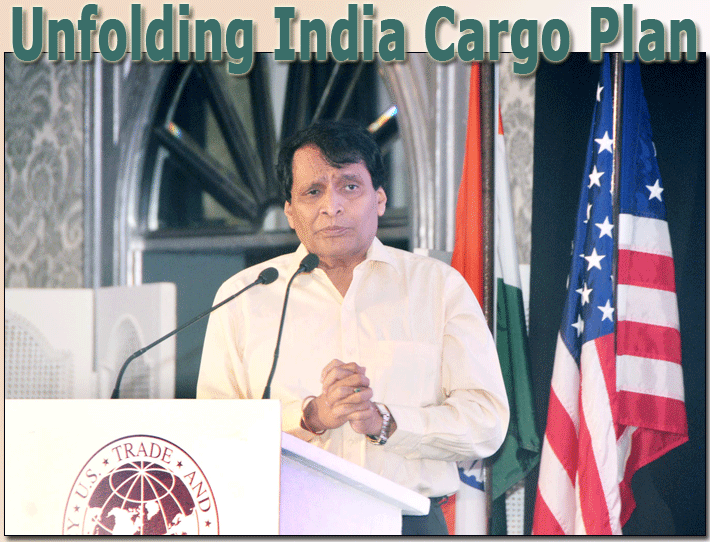
Union Minister for Civil Aviation Suresh
Prabhu addressing the recent U.S.-India Aviation
Summit in Mumbai. |
India’s
Civil Aviation Minister Suresh Prabhu recently
announced that a blueprint was
under preparation for ways to deal with infrastructure
constraints in the aviation sector.
Named the ‘Vision
2035’, the roadmap for growth will not only
look at enhancing and improving existing airports
and runways but also the development of unserved
and underserved airports. This would be especially
helpful for the government’s ambitious UDAN
(Ude Desh Ka Aam Nagrik or "Let the common
citizen of the country fly”) initiative
that seeks to boost air connectivity to small
cities and towns. Incidentally, Vision 2035 will
also provide a clear plan on cargo infrastructure
development.
New
Deal For Air Cargo
Coming as it does
on the cusp of the civil aviation sector’s
phenomenal 19 percent annual growth in the last
four years, Vision 2035, according to air cargo
stakeholders, has been a welcome move, though
a tad delayed.
They point out that
infrastructure moves to accommodate an additional
2 million metric tons to meet the projected air
cargo demand (cargo handling capacity of airports:
4.63 million tons) in the next five years –
have been taken with the government planning to
invest around $133 million USD at airports for
infra projects that include air cargo.
Adding
Enhanced Cargo Facilities
 The
Airports Authority of India (AAI) has put up already
21 common user domestic cargo terminals at its
airports. Significantly, measures are being taken
to reduce cargo release time to two days for air
imports and only one day for exports. The
Airports Authority of India (AAI) has put up already
21 common user domestic cargo terminals at its
airports. Significantly, measures are being taken
to reduce cargo release time to two days for air
imports and only one day for exports.
Infrastructure hurdles
notwithstanding, foreign cargo carriers have done
exceedingly well.
The Cathay Share
Take, for example,
Cathay Pacific. Cargo from India was "certainly
playing its part" in that positive first
quarter, according to Anand Yedery, (right) Regional Cargo Manager, South Asia, Middle East
and Africa (SAMEA) with “each of our six
ports reporting tonnage growth of more than 40
percent”.
Yedery, who served
as top Cathay cargo executive in India before
taking up the SAMEA position – mentioned:
“We are pleased
to have a positive story to tell after some challenging
years.
“We have operated
additional freighters, including 18 to Delhi alone.
While the number
of passenger aircraft operating in the Indian
market is growing, this means the additional cargo
capacity is in belly holds.
“There is,
therefore, a continuing opportunity for operators
to handle demand for main deck shipments.
“And we seem
to be getting the balance right between flexibility
and guaranteed space for our customers.”
Air
Cargo Policy
It can be pointed
out that barely a month ago, Minister Prabhu had
spoken about drafting a policy that would boost
air cargo.
“We are trying
to make a policy for air cargo so that the aviation
market can grow, which in turn will boost the
trade and economy of the country,” he said.
Lauding the cooperation
and participation of private players in helping
aviation grow, Minister Prabhu noted that the
country would need similar participation by entrepreneurs
and private entities to create cargo infrastructure.
 Celebi
Checks In Celebi
Checks In
Ramesh Mamidala,
CEO, Celebi Delhi Cargo Terminal Management, is
certain that some airports do possess the capability
to do faster transshipments.
He cited his own
airport as one that is in the process of having
a dedicated transshipment facility with “3,
6 and 12 hours connection windows for different
products and commodities.
“The facility,”
he said, “will have the necessary infrastructure,
as well as standard handling equipment, large
screening machines and ETDs.”
 The
Singh Song The
Singh Song
Manoj Singh, (left) Senior Vice President and Head of Cargo, GVK-Mumbai
International Airport (MIAL), is optimistic about
transshipment.
He pointed out that
the gateway airports could be transformed into
air cargo hubs, once the regional connectivity
program takes off.
It will be beneficial
if the regional airports are connected to the
“established major gateway airports. This
will facilitate a strong hub and spoke model that
will promote air transshipments,” Mr. Singh
notes.
He was quick to
mention the upcoming Greenfield Navi Mumbai Airport,
where work has already started.
“Its proximity
to the seaport will make that location an ideal
transshipment hub,” Mr. Singh added.
Tirthankar Ghosh
|




 Vol.
17 No. 37
Vol.
17 No. 37 Vol.
17 No. 38
Vol.
17 No. 38